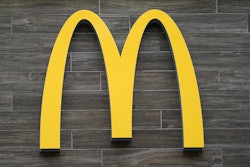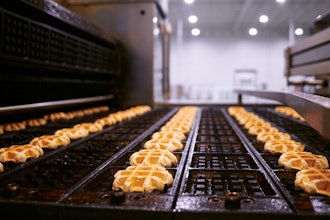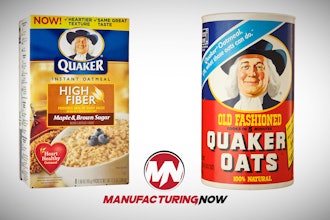Food manufacturers across the globe are currently facing some monumental challenges, including some of the biggest brands in the business. The marketplace itself has grown incredibly competitive and saturated, with an endless supply of mature products and fewer and fewer opportunities for success and growth. According to IBISWorld, there are more than 600,000 businesses in the food and beverage industry.
Competition also grows from a need to secure consumer dollars, deal with shrinking margins, balance disparate material prices and manage operating costs.
It means the only way to develop a sustainable operation is to prioritize efficiency. Luckily, there are many paths to achieve this, whether through equipment and tools purchasing, research and development, adopting new technologies or outfitting the workforce.
There is no room to sacrifice product quality or output, especially in the face of growing consumer demand. Furthermore, strict regulatory policies and a need for better transparency across the entire supply chain now pose sizeable obstacles in the way of maximum optimization.
It’s about balancing these many systems, processes and policies in a way that is conducive to higher yields. How does one achieve such a thing? We’re going to take a look at several methods food manufacturers can employ to boost efficiency.
1. Tighten Quality-Control Policies
Food recalls, shoddy goods and negative public perception and health impact will significantly ruin any progress you’ve made — whether you've spent weeks or years in the business. It stands to reason quality control should be a high priority within your organization.
To ensure such a thing, you must employ the necessary systems, tools and policies that call for a strict vetting of all goods before they leave the plant. Metal detectors and X-ray systems can help scan items or goods for foreign objects. Temperature and climate control systems can help monitor for potential contaminants or detrimental changes. Secure and restrictive employee uniforms can prevent human elements such as hair or bodily fluids. Finally, there should be an inspection process in place that also considers industry and government regulations for both safety and sanitation.
One example is fluids or goods that must remain appropriately transferred without settling. Using the right equipment — such as the proper vibration systems — will keep raw materials and processed foods from lingering static.
2. Preventive Maintenance
Machinery and equipment are instrumental in the development and packaging of various goods. When it breaks down or experiences failures, not only can it put a dent in productivity, but it can also have a negative impact on the quality of foods or goods.
It behooves the organization to implement a preventive maintenance strategy to protect equipment from failure and prepare for inevitable downtime. In fact, with the right preparation, you can better deal with unscheduled downtime and ensure operations are up and running faster. That entails having replacement parts and troubleshooting methods in place before a significant outage.
3. Inventory Tracking
It’s essential not only to maintain proper levels of outgoing inventory, but also suitable quantities of sourced and raw materials that feed into production. The best way to ensure this is to establish a proper inventory tracking system that can highlight any shortages and help with the acquisition of new materials. Automation and AI tools that can programmatically monitor and acquire new goods would be highly beneficial in this regard.
4. Employee Training Programs
Believe it or not, one of the primary contributing factors to food contamination comes from human contact or negligence. Food safety training and proper handling protocols are, therefore, vital to the development of high-quality foods and goods.
In a joint effort between major organizations and the FDA, the industry is deploying new rules and processes for training workers on proper handling techniques. Interactive and virtual training experiences can train new hires and personnel in a highly customized environment, much like the real thing. It improves product quality and prevents contamination, yes, but it’s also a great way to boost productivity through more accurate and responsible handling processes. Workers learn precisely what they need to do and when, without affecting actual workflows and goods until they’re ready.
5. Workflow Efficiency Improvements
Existing processes, technologies and workflows can have a direct impact on the productivity and efficiency of production. In many cases, you may need to replace or outfit existing processes to more modern specifications.
To start, map out existing workflows so you can better understand how your current setup fits into the overall scheme of performance, which will allow you to identify or specify areas of improvement. You may need to deploy automation software or equipment in place of manual processes. In other cases, you may need to swap out retro hardware for new, more efficient technologies. The key is first identifying what you can improve, and what’s causing a bottleneck for your operation(s).
5. Cleaner Work Environments
In the food and beverage industry especially, dirty or disorganized work environments can contribute to a higher potential for contamination. But clutter can also destroy productivity and reduce movement and operations. It’s crucial to ensure factory environments are both clean and organized, to remove physical obstacles that may be standing in workers' way.
That includes establishing a cleanup process for your workers, so they understand their local work area should be tidy at all times.
Of course, some other ways to prioritize organization include:
- Reducing travel time and distance when possible
- Eliminating unnecessary equipment or tools or moving them to another area entirely
- Regularly organizing and cleaning materials, documents and equipment
- Optimizing layouts for the task(s) at hand, and if necessary, surveying workers for guidance
- Orienting supplies or inventory, so they are close to the needed location
- Deploying automation or AI software to eliminate manual redundancies
Increased Productivity Is Better for Business
Ultimately, increased productivity will result in the improvement of a variety of elements for business, including a boost in revenue and both customer and employee satisfaction. Throughout your organization, prioritize efficiency to the point where you consider regular progress updates and make positive changes to secure high levels of performance. At the same time, ensure you are doing this in a way that’s conducive to productivity, as opposed to hindering it.
Overall, be prepared to honor and adopt the processes and technologies that will result in higher values across the board — performance notwithstanding.






















